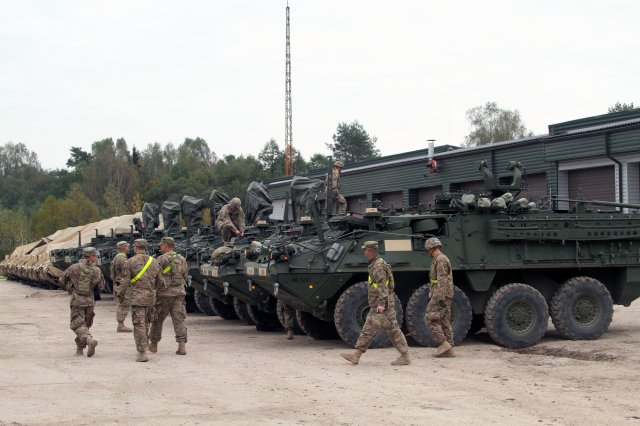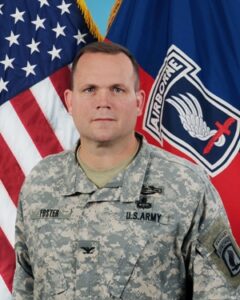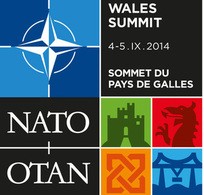Putin Won’t Blitz Baltic States — But NATO Has A Plan….
Posted on

Army Stryker vehicles arrive in Lithuania in October.
WASHINGTON: Vladimir Putin won’t blitzkrieg the Baltic states any time soon. It’s not his style, said the commander of the soldiers sent to the three small NATO nations last year to reassure them.
That’s good news — especially in light of the bad news: The US effort to shore up its eastern allies and Ukraine, while expanding, remains anemic in comparison to the full-blooded Russian threat.
“We’ve had some great discussions on what do we do in case of Russian aggression, in case of kinetic or lethal activity in the vicinity of our soldiers,” said Col. Michael Foster, commander of the Italy-based 173rd Airborne Brigade, this morning at the Center for Strategic & International Studies. “I think we’ve got a good plan in place…. I’d be wrong if I told you what it was.”

Col. Michael Foster
“If we find ourselves in an Article 5 situation,” Foster said, referring to the mutual defense clause of the NATO treaty, “we will end up with some form of a coalition taking action and not necessarily a 28-member alliance. Some of these places you don’t want, necessarily, 28 countries involved…. I certainly would not be surprised to see that put to the test in the next 18-24 months.”
But a bolt-from-the-blue Russian invasion of the Baltic States or elsewhere is highly likely, Foster argued. “It’s not something that keeps me up at night,” he said. Yes, the Russians have demonstrated the capability to rapidly mass forces on borders or to execute menacing “exercises,” he said, but the capability and the will to use it are two very different things.
“It’s absolutely possible,” Foster said. “Is it likely?….Given what has worked for them in the past and their standard operating procedure” — the use of local proxies stiffened by deniable Russian contingents — “to think that they would change that tactic in midstream, something that’s worked for, something that’s incredibly risky, I have a hard time thinking that’s likely.”
But “unlikely” is not so reassuring for a small country, for which a Russian fait accompli would be an existential threat. If Putin seizes a Crimea-sized chunk of Estonia — the smallest Baltic state and his favorite target — that’s 60 percent of the country gone.
So the nations most exposed to Russia care more about having US troops on their soil than hearing US assessments of Russian intentions. To restore their peace of mind and preserve the peace of Europe, the US is expanding the “Atlantic Resolve” deployments begun last summer. “By the end of the summer you could very well see an operation that stretches from the Baltics all the way down to the Black Sea,” Foster said.
Elements of the 3rd Infantry Division will deploy from Fort Stewart, Ga. to beef up Atlantic Resolve, along with part of the 4th Infantry Division headquarters to provide high-level command-and-control. (Army division HQs are in high demand, with nine of 10 currently deployed, though the 101st Airborne is just coming back from Africa as the 4th Infantry is leaving). The ongoing deployments to Poland and the Baltics will be renamed “Atlantic Resolve North,” Foster said. A new “Atlantic Resolve South” will put troops in Bulgaria, Romania, and potentially other countries such as the Czech Republic, Hungary, and even Georgia. Georgia is the most sensitive country on that list since it’s the only non-NATO country on the list and the only one that’s fought a recent war with Russia.
As for the non-NATO country currently at war with Russia, Ukraine, Foster’s brigade is deploying not quite a full battalion there this week to train the local forces. Over the summer, three US battalion headquarters elements and six line companies will train three battalion HQs and six line companies from the Ukrainian National Guard.
Six companies is definitely a start, but in most military organizations that’s less than a thousand soldiers. Most estimates put thousands of Russian troops in Ukraine, and that’s not even counting local separatist militiamen. The separatists and/or their Russian mentors also have heavy weapons such as tanks and anti-aircraft missiles that the 173rd Airborne lacks. (And which the Obama administration won’t sell to Ukraine).

Logo of September’s NATO summit in Wales
Where light infantry units like the 173rd excel is in rapid deployment to a crisis spot, since they don’t have heavy equipment to haul. It was another airborne unit, the 82nd Airborne Division, that was the first US force into Saudi Arabia in 1990 but was characterized as the “speed bump” if Saddam Hussein’s tanks decided to drive south. Foster’s brigade has at least a company ready to deploy on 18 hours’ notice at all times, he said — although, again, infantry companies are the small change of modern warfare.
Most NATO countries have some kind of rapidly deployable light troops, and the alliance could aggregate them into a much larger crisis-response force, Foster said, “but I haven’t seen a definitive plan to see so.” Last year’s Wales summit created a “NATO Response Force” but it’s still very much a work in progress.
While the Europeans get organized, the US is moving ahead, albeit on a modest scale. “The two thought processes are the same,” Foster said. “The opportunity is there to marry those two efforts up…but I haven’t seen a definitive plan to do that.”
After Foster’s talk, I asked the CSIS moderator, Maren Leed, if she was as discouraged about the scale of US efforts (or the lack thereof) as I was.
“It’s true we’re not doing a ton, but there are a couple of things important to keep in mind,” Leed told me. “Six companies is paltry for us, but not for the Baltics or even Ukraine. So there’s a big capacity constraint on their side.” In other words, there’s only so much US training the (very busy) Ukrainian military can absorb.
“Second, it’s not clear to me how much you’d really need, depending on what their real purpose is,” Leed continued. “If we have US soldiers inside Ukraine, I don’t really care what they’re doing, I think it makes it a lot more unlikely that things will happen inside Ukraine (even little green men).”
“There’s a distinction to be made between the tactical/operational effect and the strategic one,” Leed said. As a deterrent to aggression and a tripwire triggering US commitment, a small force can have a strategic impact out of proportion to its size.
Corrected 1:20 Tuesday: The original version of this article stated the 3rd Infantry Division headquarters was deploying to Europe; it is in fact the 4th Infantry Division HQ.
Subscribe to our newsletter
Promotions, new products and sales. Directly to your inbox.
